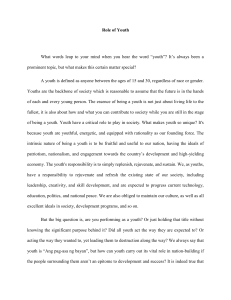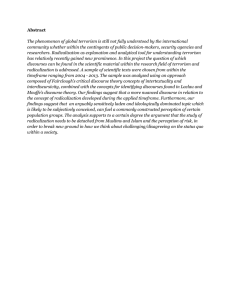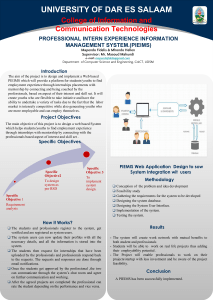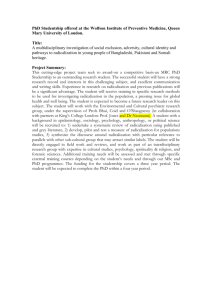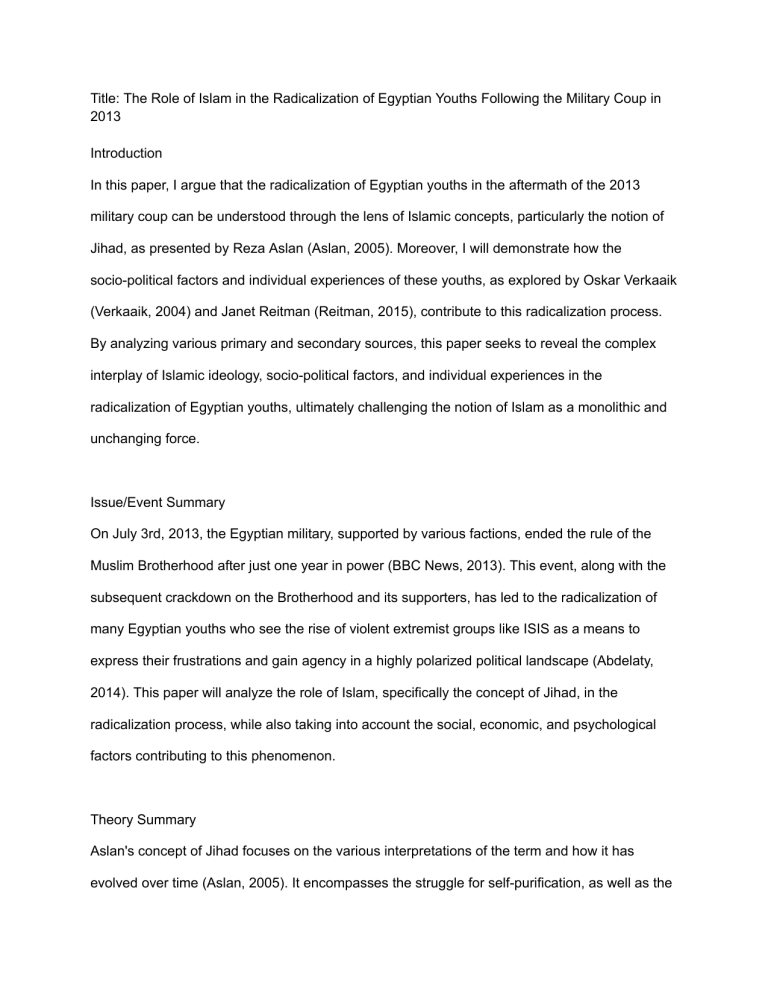
Title: The Role of Islam in the Radicalization of Egyptian Youths Following the Military Coup in 2013 Introduction In this paper, I argue that the radicalization of Egyptian youths in the aftermath of the 2013 military coup can be understood through the lens of Islamic concepts, particularly the notion of Jihad, as presented by Reza Aslan (Aslan, 2005). Moreover, I will demonstrate how the socio-political factors and individual experiences of these youths, as explored by Oskar Verkaaik (Verkaaik, 2004) and Janet Reitman (Reitman, 2015), contribute to this radicalization process. By analyzing various primary and secondary sources, this paper seeks to reveal the complex interplay of Islamic ideology, socio-political factors, and individual experiences in the radicalization of Egyptian youths, ultimately challenging the notion of Islam as a monolithic and unchanging force. Issue/Event Summary On July 3rd, 2013, the Egyptian military, supported by various factions, ended the rule of the Muslim Brotherhood after just one year in power (BBC News, 2013). This event, along with the subsequent crackdown on the Brotherhood and its supporters, has led to the radicalization of many Egyptian youths who see the rise of violent extremist groups like ISIS as a means to express their frustrations and gain agency in a highly polarized political landscape (Abdelaty, 2014). This paper will analyze the role of Islam, specifically the concept of Jihad, in the radicalization process, while also taking into account the social, economic, and psychological factors contributing to this phenomenon. Theory Summary Aslan's concept of Jihad focuses on the various interpretations of the term and how it has evolved over time (Aslan, 2005). It encompasses the struggle for self-purification, as well as the fight against oppression and injustice. As Aslan notes, "the primary meaning of the word jihad is not 'holy war' but 'struggle.' It refers to the difficult effort that is needed to put God's will into practice at every level—personal and social as well as political" (Aslan, 2005, p. 77). Verkaaik's notion of urban violence explores the relationship between migration, social dislocation, and the rise of militant organizations in Pakistan (Verkaaik, 2004). Reitman's analysis of the appeal of ISIS highlights the role that identity, belonging, and a sense of purpose play in attracting disenfranchised youths to radical movements (Reitman, 2015). Reitman states, "the appeal of ISIS goes beyond its religious or political rhetoric. For many young recruits, the group offers a sense of belonging, a chance to be part of a larger, transnational movement with global aspirations" (Reitman, 2015, p. 43). Issue/Event Analysis a. Aslan's concept of Jihad The radicalization of Egyptian youths can be understood through the lens of Aslan's concept of Jihad, as these individuals may view their struggle against the military regime and its supporters as a legitimate form of Jihad (Aslan, 2005). The crackdown on the Muslim Brotherhood and the repression of political dissent have created an environment conducive to the radicalization of disillusioned youths who may see violent resistance as the only viable option for change (Al Jazeera, 2014). As one young Egyptian radical explained, "the coup destroyed the hope that we could achieve change peacefully. Now, the only option left is to take up arms and fight for our rights" (Aly, 2017). In this context, Jihad becomes not just a religious concept buta political one, as it provides a framework for understanding and justifying the violent actions of these radicalized youths (Kirkpatrick, 2014). b. Verkaaik's notion of urban violence Verkaaik's analysis of urban violence in Pakistan provides a useful framework for understanding the social and economic factors contributing to the radicalization of Egyptian youths (Verkaaik, 2004). The combination of social dislocation, economic hardship, and political repression in Egypt has created fertile ground for the growth of radical movements (El-Sherif, 2015). Many of these youths come from marginalized backgrounds and have experienced significant hardship in their lives, making them more susceptible to the allure of extremist ideologies (Malsin, 2015). As Verkaaik argues, "migrants and other marginalized groups in the urban environment often turn to violence as a means of asserting their identity and carving out a space for themselves within an increasingly hostile society" (Verkaaik, 2004, p. 123). In this sense, the radicalization of Egyptian youths can be seen as a manifestation of the socio-economic and political forces shaping their lives. c. Reitman's analysis of the appeal of ISIS Reitman's examination of the appeal of ISIS to young recruits underscores the importance of identity, belonging, and a sense of purpose in understanding the radicalization process (Reitman, 2015). The Egyptian youths who have joined extremist groups like ISIS often cite feelings of alienation and marginalization as key factors driving their decision to take up arms (Aly, 2017). As Reitman notes, "ISIS offers these young people a sense of purpose and identity that they may not be able to find elsewhere, and its sophisticated propaganda machine is adept at exploiting these vulnerabilities" (Reitman, 2015, p. 45). For many Egyptian youths, the appeal of radical movements lies not only in the promise of power and revenge but also in the opportunity to be part of something larger than themselves, a community that transcends the boundaries of nation and ethnicity (Abdelaty, 2014). Discussion and Conclusion The radicalization of Egyptian youths following the 2013 military coup can be seen as both a manifestation of and challenge to existing theories on the role of Islam in contemporary society. While Aslan's concept of Jihad, Verkaaik's notion of urban violence, and Reitman's analysis of the appeal of ISIS help to illuminate the complex factors contributing to radicalization, they also reveal the need for a more nuanced understanding of the role of Islam in shaping individual and collective identities, as well as the potential for change and adaptation within the Islamic tradition. In conclusion, the case of radicalized Egyptian youths underscores the importance of considering the role of Islam as both a spiritual and political force in shaping contemporary events and issues. By examining the interplay of Islamic concepts, socio-political factors, and individual experiences, we can gain a deeper understanding of the forces driving radicalization and develop more effective strategies for addressing this pressing challenge. References Abdelaty, A. (2014). Egypt's lost youths are a ticking time bomb. The Guardian. Retrieved from https://www.theguardian.com/world/2014/feb/13/egypt-lost-youths-ticking-time-bomb Al Jazeera. (2014). Egypt's 'disappeared' youth. Al Jazeera. Retrieved from https://www.aljazeera.com/features/2014/8/17/egypts-disappeared-youth Aly, W. (2017). The minds of the young men who join ISIS. The Atlantic. Retrieved from https://www.theatlantic.com/international/archive/2017/02/the-minds-of-the-young-men-who-joinisis/516216/ Aslan, R. (2005). No god but God: The origins, evolution, and future of Islam. New York: Random House. BBC News. (2013). Egypt crisis: Army ousts President Mohammed Morsi. BBC News. Retrieved from https://www.bbc.com/news/world-middle-east-23173794 El-Sherif, A. (2015). Egypt's new radicals: The youth and the rise of ISIS. The Cairo Review of Global Affairs. Retrieved from https://www.thecairoreview.com/essays/egypts-new-radicals/ Kirkpatrick, D. D. (2014). Egypt's rising radical insurgency. The New York Times. Retrieved from https://www.nytimes.com/2014/10/31/world/middleeast/egypts-rising-radical-insurgency.html Malsin, J. (2015). Why so many Egyptian youths are joining ISIS. TIME. Retrieved from http://time.com/3716182/egypt-youth-isis/ Reitman, J. (2015). The children of ISIS. Rolling Stone, April 9, 2015, 40-49, 64-65. Verkaaik, O. (2004). Migrants and Militants: Fun and Urban Violence in Pakistan. Princeton, New Jersey: Princeton University Press.
